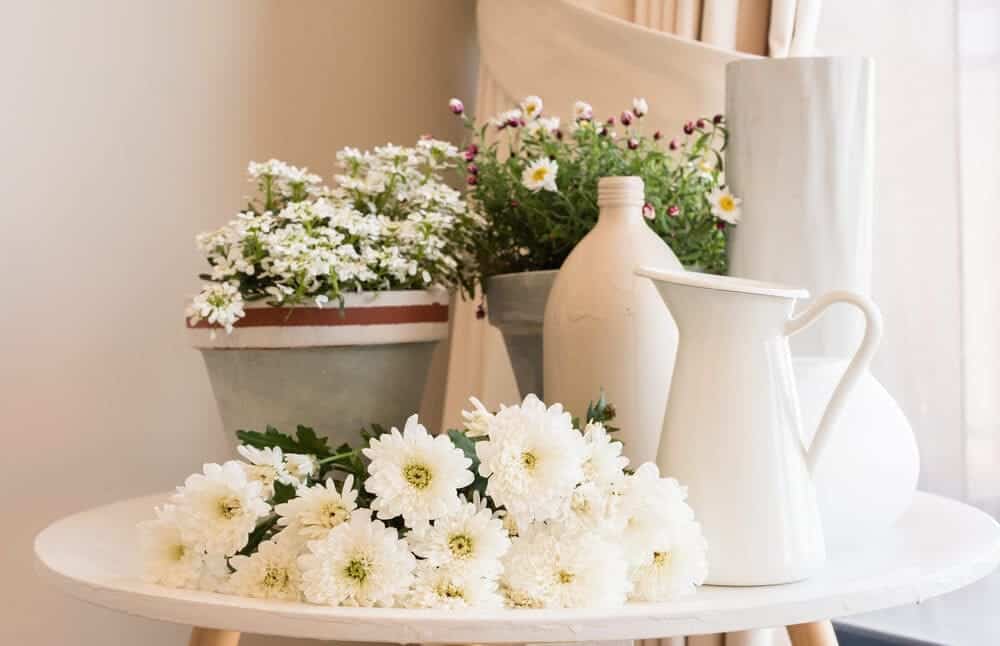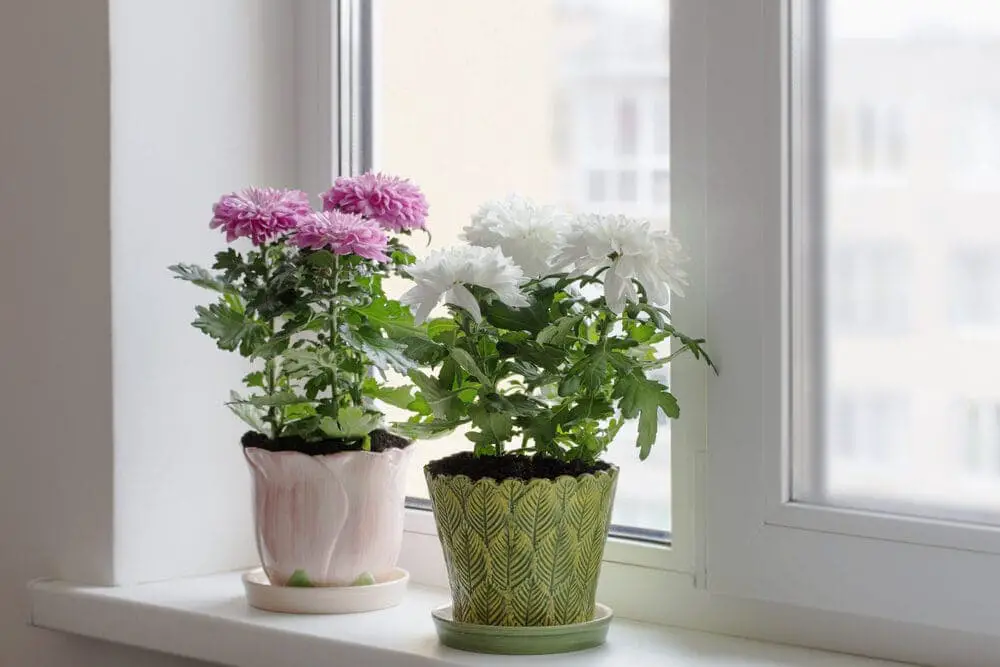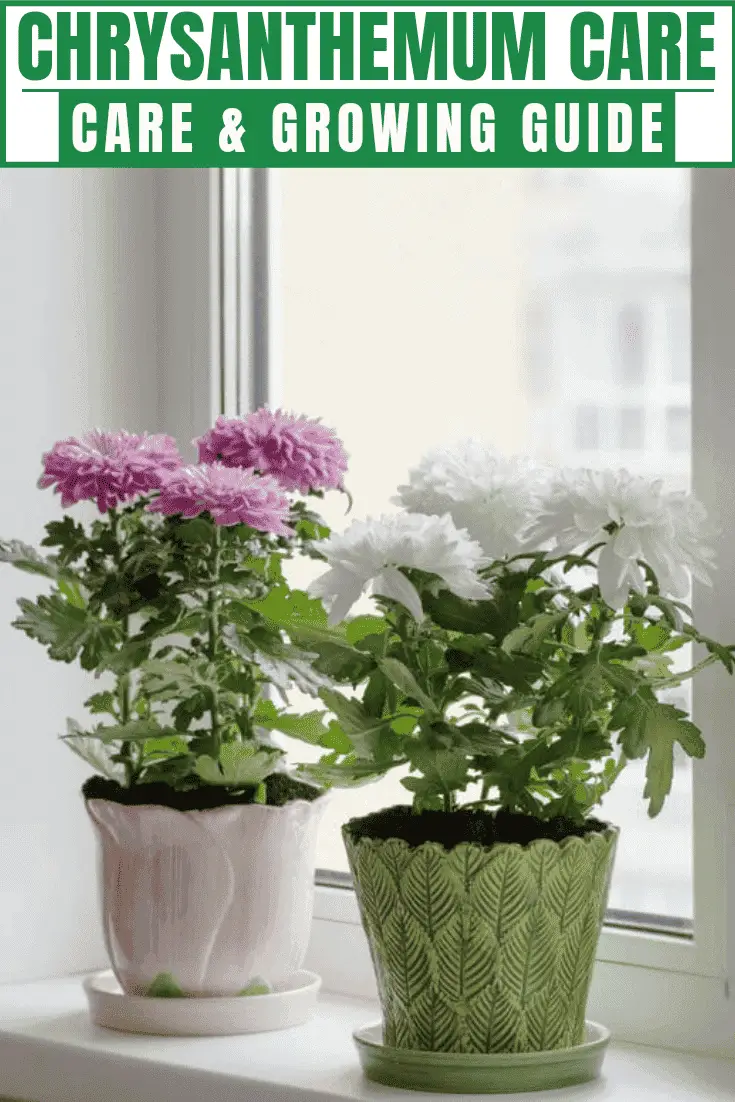Chrysanthemums are beautiful plants that decorate any garden that they reside in.
Their flowers bloom and carpet the ground. Even Disneyland loves chrysanthemums for their beautiful blooms. There are many different types of chrysanthemums out there in the world, and each one is unique and gorgeous.
Chrysanthemum Care & Growing Guide
1. Light Requirement
Chrysanthemums like to get a lot of light. Place them in areas where they can receive full sun, around six hours a day, at least. If they don’t receive enough direct light, their stems will grow taller than usual, and they will produce fewer flowers. If they are indoors, make sure they are next to a window that allows the sun’s rays to shine through.
2. Water
This plant requires a lot of water for its flowers to bloom. Always keep new plants thoroughly watered. When they reach their mature stage, they will need about an inch of water a week. If the leaves at the bottom start to turn brown, then it needs to be watered even more. Do not spray them with water overhead; water them right at the soil.
3. Climate and temperature
Chrysanthemums are delicate when it comes to the heat. Their flowers are tender and can easily be scorched by the sun. If they are in pots, do not put them outdoors too early. Wait until the heat of summer has mostly passed. If temperatures are around 85 degrees or higher, the plant won’t flower or bloom to protect itself. Chrysanthemums do best in hardiness zones 5 through 9. This flowering plant also does not do well in the cold or frost.
4. Soil
The right type of soil for chrysanthemums is well-drained soil mixed with perlite. It can’t be too dense because then, the roots can’t grow farther, and the water will stay stagnant around the plant, causing disease and rot. If you need to fertilize the soil, do it once or twice a month and stop when cold weather sets in. Try to keep the soil’s pH around 6.5.

5. How to repot Chrysanthemums?
Generally, springtime is the best time to repot a chrysanthemum. Before you repot a chrysanthemum, water it the day before you mean to change it out. The soil sticks better to the plant if it is damp. Retrieve a larger pot and fill it with 3 inches of good potting soil, then take the plant and turn upside down. Wiggle the plants out of the pot. After, place the chrysanthemum with its potting soil and roots and all into the new container and slowly fill the chrysanthemum plants up with new soil. Then water it slightly and place it in indirect sunlight.
6. Speed of Growth
Since there are so many types of chrysanthemums, it’s hard to establish a basic growth speed. Some plants take several years to reach three feet, but others can reach it in only one. But what does affect the rate of growth is proper lighting and moist soil.
7. Height and width of the plant
One single chrysanthemum plant can grow to be three feet tall. Its width can reach up to 3 feet as well.
8. Trimming
Chrysanthemums need to trimmed or pinched in the early summer. First, you must remove all foliage that does not end in a flower. Also, remove all of the dead or decaying foliage. If the foliage needs to be pinched back, it must be done before July 13th. This is because it will not delay the flowers bloom later in the year.
How do I propagate Chrysanthemums?
Yes, the chrysanthemum plant can be propagated. First, remove a full strong stem that has no flowers. Then remove the bottom leaves if there are any. Then dip the cut part into the root hormone and repot it into a small container with soil. The cuttings take about four to six weeks to develop strong roots.

Are Chrysanthemums Poisonous?
Yes, the chrysanthemums are poisonous to animals, especially small ones. They are not toxic to humans. However, if the sap from the plant touches our skin, we will develop a rash.
Can Chrysanthemums grow in water?
No, the chrysanthemum plant is not suited to be grown in water. This plant must be moist, not waterlogged. But during propagation, the plant can be rooted in water before it is added to its soil container.
Do Chrysanthemums have flowers and how to get it to flower?
Of course, all chrysanthemum plants have beautiful flowers that are amazing to look at and improve any garden that they’re in. But the flowers are delicate, so they need proper care and maintenance. They will not bloom if it is too hot or too cold. Trim off any dead flowers or diseased-looking leaves. Make sure to water the plant often but not from overhead. Fertilizer also improves the blooming of the chrysanthemum flower
Common Chrysanthemums Diseases
Aphids kill everything in their path when they land on the chrysanthemum plant. They crawl all over the stems and flowers, sucking out the sap and destroying the structure of the plant. To get rid of aphids, you must butter spray the entire plant with water thoroughly. The next day, after you have sprayed the plant, apply neem oil or another insecticide to keep them away.
Leaf spot occurs when there is too much humidity for a plant that is not built to deal with humidity. You can tell if leaf spot is happening to your plants when you see large black spots all over the leaves. Leaf spot is a fungus, so you must buy a fungicide to fight it off. First, remove all diseased foliage from all affected plants. Throw them away, do not try to compost them. Then spray the fungicide all over the plant. Repeat the application of fungicide until you no longer see any more black spots.
Conclusion
- Keep the soil underneath the chrysanthemum damp
- It can grow up to 3ft tall.
- It cannot be watered overhead. It has to be watered right by its soil.
- Another name for the chrysanthemum is just mum.
- this flowering plant does not do well in the cold. Its flowers will not bloom if they are too hot or cold
- This plant is poisonous to cats and dogs if it is eaten.

Victoria is the owner and main author of hobby plants. She loves spending her free time in her garden planting and taking care of her plants. Victoria hopes you enjoy the content here!
![Queen Of The Night Flower [Complete Plant Care Guide] Queen Of The Night Flower [Complete Plant Care Guide]](https://www.hobbyplants.com/wp-content/uploads/2022/07/queen-of-the-night-flower-300x158.jpg)
![Mother Of Thousands Plant [Complete Plant Care Guide] Mother Of Thousands Plant [Complete Plant Care Guide]](https://www.hobbyplants.com/wp-content/uploads/2022/07/mother-of-thousands-plant-300x158.jpg)
![How Often Should You Water Pothos? [Complete Care Guide] How Often Should You Water Pothos? [Complete Care Guide]](https://www.hobbyplants.com/wp-content/uploads/2022/07/how-often-to-water-pothos-300x158.jpg)
![Can Snake Plants Live Outside? [COMPLETE CARE GUIDE] Can Snake Plants Live Outside? [COMPLETE CARE GUIDE]](https://www.hobbyplants.com/wp-content/uploads/2022/08/can-snake-plants-live-outside-300x158.jpg)
![Majesty Palm Plant Care: [Complete Beginner's Guide] Majesty Palm Plant Care: [Complete Beginner's Guide]](https://www.hobbyplants.com/wp-content/uploads/2022/08/majesty-palm-care-300x158.jpg)
![Exotic Angel Plant Care: [Complete Beginner's Guide] Exotic Angel Plant Care: [Complete Beginner's Guide]](https://www.hobbyplants.com/wp-content/uploads/2022/08/exotic-angel-plant-care-300x158.jpg)
![Do Coleus Like Sun Or Shade: [Complete Care Guide] Do Coleus Like Sun Or Shade: [Complete Care Guide]](https://www.hobbyplants.com/wp-content/uploads/2022/08/coleus-sun-or-shade-300x158.jpg)
![Snow White Waffle Plant: [Complete Care Guide] Snow White Waffle Plant: [Complete Care Guide]](https://www.hobbyplants.com/wp-content/uploads/2022/08/snow-white-waffle-plant-300x158.jpg)
![Waffle Plant Care: [Complete Beginner's Guide] Waffle Plant Care: [Complete Beginner's Guide]](https://www.hobbyplants.com/wp-content/uploads/2022/08/waffle-plant-300x158.jpg)
![Bird Of Paradise Plant Care: [Complete Beginner's Guide] Bird Of Paradise Plant Care: [Complete Beginner's Guide]](https://www.hobbyplants.com/wp-content/uploads/2022/08/bird-of-paradise-plant-300x158.jpg)
![Purple Passion Plant Care: [Complete Beginner's Guide] Purple Passion Plant Care: [Complete Beginner's Guide]](https://www.hobbyplants.com/wp-content/uploads/2022/08/purple-passion-plant-care-300x158.jpg)
![China Doll Plant Care: [Complete Beginner's Guide] China Doll Plant Care: [Complete Beginner's Guide]](https://www.hobbyplants.com/wp-content/uploads/2022/09/china-doll-plant-care-300x158.jpg)